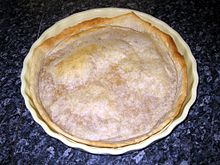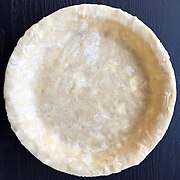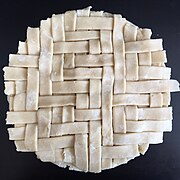
Dessert is a course that concludes a meal. The course consists of sweet foods, such as cake, biscuit, ice cream and possibly a beverage such as dessert wine and liqueur. Some cultures sweeten foods that are more commonly savory to create desserts. In some parts of the world there is no tradition of a dessert course to conclude a meal.

Puff pastry, also known as pâte feuilletée, is a flaky light pastry made from a laminated dough composed of dough and butter or other solid fat. The butter is put inside the dough, making a paton that is repeatedly folded and rolled out before baking.

Baking is a method of preparing food that uses dry heat, typically in an oven, but can also be done in hot ashes, or on hot stones. The most common baked item is bread, but many other types of foods can be baked. Heat is gradually transferred "from the surface of cakes, cookies, and pieces of bread to their center. As heat travels through, it transforms batters and doughs into baked goods and more with a firm dry crust and a softer center". Baking can be combined with grilling to produce a hybrid barbecue variant by using both methods simultaneously, or one after the other. Baking is related to barbecuing because the concept of the masonry oven is similar to that of a smoke pit.

Pastry is baked food made with a dough of flour, water, and shortening that may be savoury or sweetened. Sweetened pastries are often described as bakers' confectionery. The word "pastries" suggests many kinds of baked products made from ingredients such as flour, sugar, milk, butter, shortening, baking powder, and eggs. Small tarts and other sweet baked products are called pastries as a synecdoche. Common pastry dishes include pies, tarts, quiches, croissants, and pasties.

A pie is a baked dish which is usually made of a pastry dough casing that contains a filling of various sweet or savoury ingredients. Sweet pies may be filled with fruit, nuts, fruit preserves, brown sugar, sweetened vegetables, or with thicker fillings based on eggs and dairy. Savoury pies may be filled with meat, eggs and cheese or a mixture of meat and vegetables.

An apple pie is a fruit pie in which the principal filling is apples. Apple pie is often served with whipped cream, ice cream, custard or cheddar cheese. It is generally double-crusted, with pastry both above and below the filling; the upper crust may be solid or latticed. The bottom crust may be baked separately ("blind") to prevent it from getting soggy. Deep-dish apple pie often has a top crust only. Tarte Tatin is baked with the crust on top, but served with it on the bottom.

A croissant is a French pastry made from puff pastry in a crescent shape.

Dough is a thick, malleable, sometimes elastic paste made from grains or from leguminous or chestnut crops. Dough is typically made by mixing flour with a small amount of water or other liquid and sometimes includes yeast or other leavening agents, as well as ingredients such as fats or flavorings.

A mooncake is a Chinese bakery product traditionally eaten during the Mid-Autumn Festival (中秋節). The festival is primarily about the harvest while a legend connects it to moon watching, and mooncakes are regarded as a delicacy. Mooncakes are offered between friends or on family gatherings while celebrating the festival. The Mid-Autumn Festival is widely regarded as one of the four most important Chinese festivals.

In baking, a crust is the outer, hard skin of bread or the shell of a pie. Generally, it is made up of at least shortening or another fat, water, flour, and salt. It may also include milk, sugar, or other ingredients that contribute to the taste or texture. An egg or milk wash can be used to decorate the outside, as well as coarse sugar. A crust contributes to a pastry.
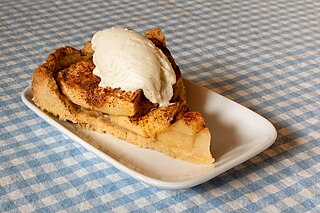
Apple cakes are cakes in which apples feature as a main flavour and ingredient. Such cakes incorporate apples in a variety of forms, including diced, pureed, or stewed, and can include common additions like raisins, nuts, and 'sweet' spices such as cinnamon or nutmeg. They are a common and popular dessert worldwide, thanks to millennia of apple cultivation in Asia and Europe, and their widespread introduction and propagation throughout the Americas during the Columbian Exchange and colonisation. As a result, apple desserts, including cakes, have a huge number of variations.
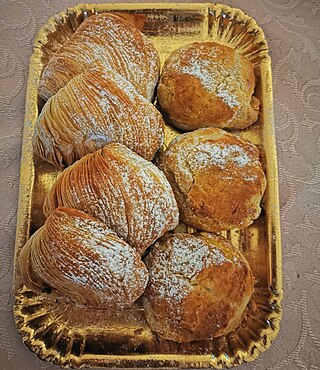
Sfogliatella, sometimes also known as a lobster tail, is a shell-shaped Italian pastry with a sweet or creamy filling, originating in the Campania region. Sfogliatella means 'small, thin leaf/layer', as the pastry's texture resembles stacked leaves.
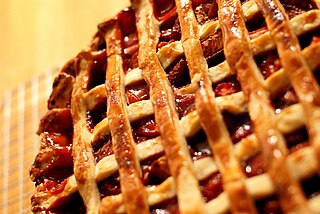
Lattice pastry is a pastry woven in a criss-crossing pattern of strips in the preparation of various foods. Latticed pastry is used as a type of lid on many various tarts and pies. The openings between the lattice allows fruit juices in pie fillings to evaporate during the cooking process, which can caramelize the filling.

A meat pie is a pie with a filling of meat and often with other savory ingredients. They are found in cuisines worldwide.
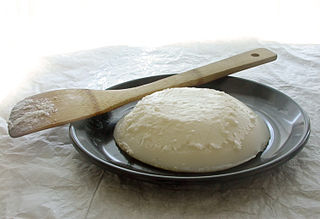
Lard is a semi-solid white fat product obtained by rendering the fatty tissue of a pig. It is distinguished from tallow, a similar product derived from fat of cattle or sheep.

Gâteau Basque is a traditional dessert from the Northern Basque region of France, typically filled with black cherry jam or pastry cream. Gâteau Basque with cream is more typical in the Southern Basque region of Spain.

Laminated dough is a culinary preparation consisting of many thin layers of dough separated by butter or other solid fat, produced by repeated folding and rolling. Such doughs may contain more than eighty layers. During baking, water in the butter vaporizes and expands, causing the dough to puff up and separate, while the lipids in the butter essentially fry the dough, resulting in a light, flaky product.
Pie in American cuisine has roots in English cuisine and has evolved over centuries to adapt to American cultural tastes and ingredients. The creation of flaky pie crust shortened with lard is credited to American innovation.
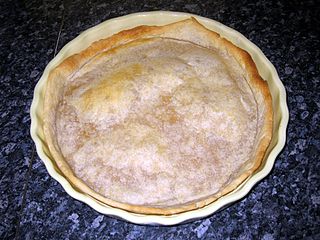
Pâte brisée is a variation on a traditional short-crust pastry dough. It is used as a base for various savory and sweet dishes. It is sometimes confused with a traditional flaky pie crust, which has similar ingredients, but the pâte brisée is considered superior for use with wet fillings such as custards. It is an unsweetened pastry typically used in savory dishes, though sweet dishes are known.
